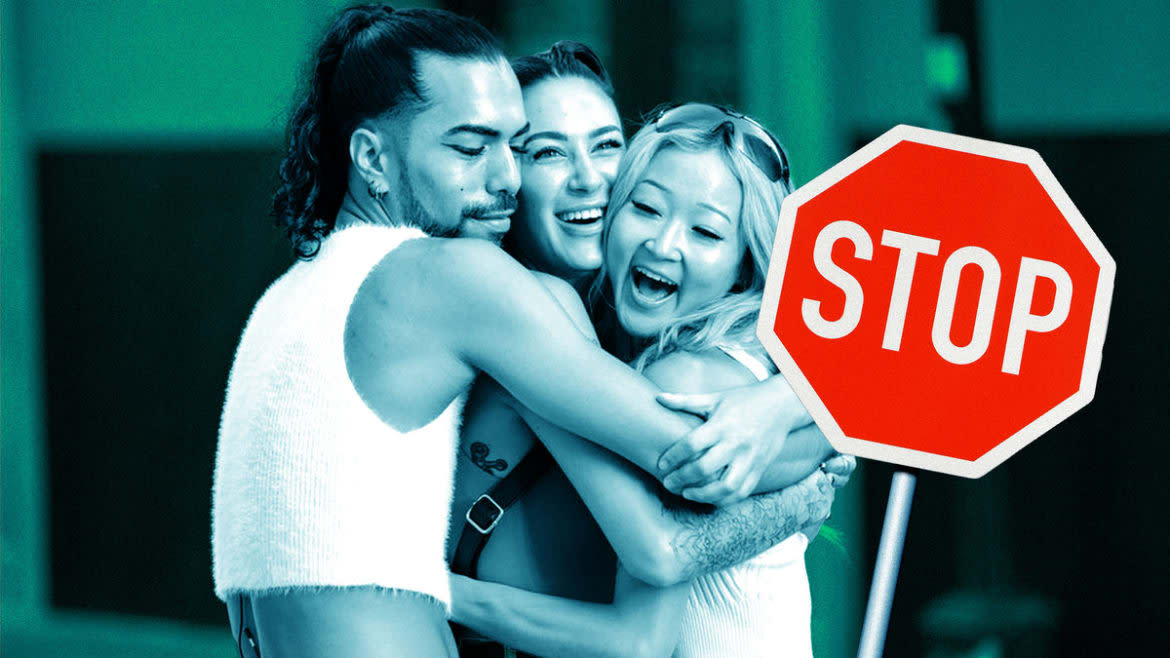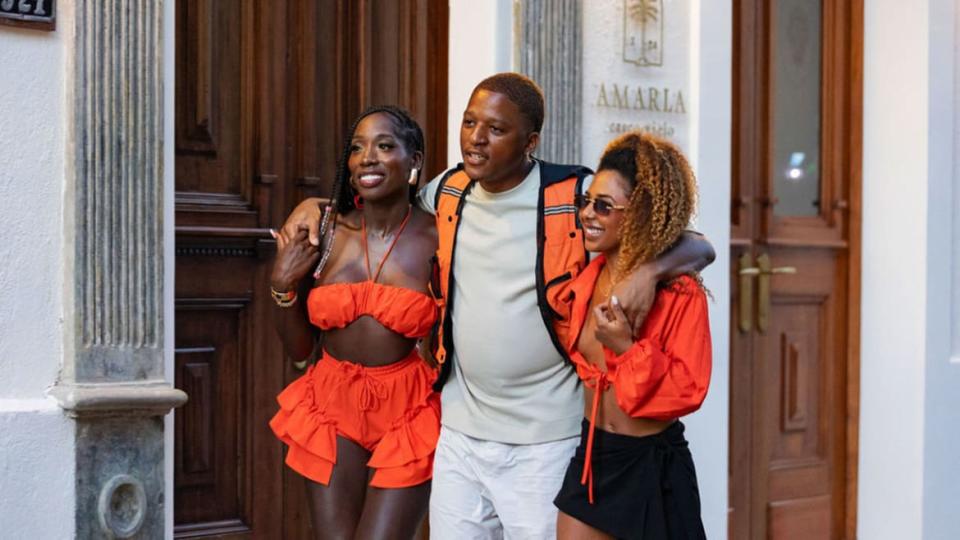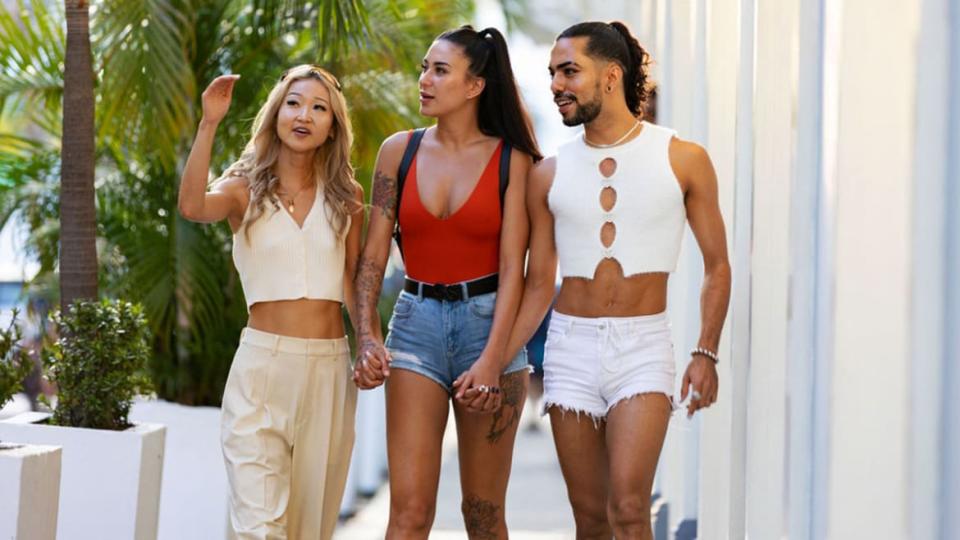‘Couple to Throuple’ Wildly Failed the Polyamory Community. We’re Not Shocked.

Going into the finale of Peacock’s newest dating show, Couple to Throuple, I was “gagged and gooped and gagged,” as Ash, one half of one of the participating couples, says in Episode 4. Ash means this as a positive thing. I am not sure how I mean it, because, while I must admit that the show has been incredible television, I can’t say that it has been a particularly good representation of polyamory or non-traditional relationship structures.
Now, look—I’m not under the delusion that all representation must be good. Straight, monogamous people have been messy as hell on reality dating shows for decades at this point. The Bachelor isn’t exactly a walking advertisement for “happily ever after.” Have you ever looked at the outcomes of the relationships from that franchise? Yikes.
At the same time, I can’t help but wonder, as Carrie Bradshaw may have on Sex and The City, is bad representation better than no representation? In trying to make predominantly queer culture legible to cishet audiences, are we doing more harm than good? (Questions about polyamory Carrie did actually ask were, “Has monogamy become too much to expect?” and, “Were threesomes the new sexual frontier?”—because I know you were wondering.) I fear that the answer is “no” to the former and “yes” to the latter, and that this portrayal of polyamory reinforces some of the worst stereotypes about the lifestyle and the people who participate in it.
The premise of Couple to Throuple is fairly simple. A group of couples with little-to-no experience with open relationships arrive at a resort in the hopes of finding a third person to add to their dyad, thus turning their couple into a “throuple” (or a “three-lationship,” as the show sometimes refers to it, which makes me want to a die a little inside each time). The thirds, most of whom have a working understanding of non-monogamy, seem to be much queerer than the majority of the couples. Three-quarters of the couples, meanwhile, consist of a cis straight man and a cis bi woman looking to add a cis woman to their relationship. (This is known as “unicorn hunting” in the wider non-monogamy community, though the show never uses that term.)

Brittne, Sean, Darrien in the series Couple to Throuple
The contestants on Couple to Throuple are part of the current wave of exploration of non-traditional relationships that’s dominating mainstream culture. Ethical non-monogamy, an umbrella of relationship structures that includes polyamory, is a topic which is trendy right now, with recent features exploring the topic in the New York Times, New York, and The New Yorker. Non-monogamous content creators and influencers—as well as some of the singles who appeared on the show—have roundly criticized the format of Couple to Throuple for several things, including throwing inexperienced couples headfirst into what is notoriously the hardest relationship dynamic; not providing enough tools for the couples new to navigating non-monogamy; prioritizing the couples’ experiences and desires over the singles; and not allowing the singles the opportunity to have fully fleshed-out narratives or needs.
“The search for thirds is very common, and it’s very commonly done unethically,” relationship coach Melissa A. Fabello tells The Daily Beast’s Obsessed, about the show’s failure to accurately portray ethical non-monogamy. “I often find that folks new to polyamory feel safest exploring a triad because they mistakenly think that jealousy will be less of a problem. But that isn’t true. And I’d hate for more people to think that triads are somehow easier than other models of non-monogamy, when this is already the most over-represented dynamic.”
But here’s the thing: This is the only kind of show about non-monogamy that could have been made for a mainstream audience. That’s because mainstream culture, while coming around to the idea of open relationships, still sees opening up a relationship as OK, as long as it’s in service of a primary (ideally straight) dyad. (Most of the recent memoirs on the topic, like Molly Roden Winter's More and Rachel Krantz’s Open, were written by women in straight pre-existing relationships.) Many couples open their relationship to pursue sex outside of it but still view the marriage or established relationship as something “primary,” deprioritizing and therefore dehumanizing their other partners.
When one of the singles on the show, Sanu, voices that she feels “dehumanized” to her couple, Sean and Brittne, they respond with anger. This experience is one they are hoping will strengthen their own relationship; they don't consider what Sanu is hoping her experience will be. Similarly, single Mia tells her couple, Dylan and Lauren, that she feels “objectified” and like the two of them are just looking for a threesome. rather than trying to build an emotional connection with her—something another single the couple matched with earlier in the series had said as well. Dylan and Lauren are deeply offended and tell the camera that they need to focus on what’s best for them as a couple, first and foremost. Yet another single, Becca, says that she feels like “option C” for Maximo and Ash, and neither does anything to reassure her or tell her that she’s wrong.
What we are witnessing is “couple privilege,” the prioritizing of an established couple, in real time, and the show does nothing to help the couples (or the audience) learn about or unpack that dynamic. Couple privilege is “the idea that the established couple is the dynamic most important to preserve, often to the detriment of anyone else involved,” explains Fabello. “This is exactly what feels dehumanizing and objectifying: the feeling that the singles are experiments for exploring the couples’ needs. The single, then, has less autonomy and is ultimately valued less than the established couple.” They are disposable once they stop serving the needs of the couple.

Ash, Becca, and Maximo in the series Couple to Throuple
In trying to establish itself as a valid lifestyle choice and sell itself to the American public, practitioners of polyamory positioned it as something intended to strengthen nuclear families and primary dyads, as detailed by Christopher M. Gleason’s recent history of the modern polyamory movement, American Poly. In other words, mainstream representations of polyamory have leaned into the idea that it is in service of the very social structure that it seems like it should be tearing down. Couple to Throuple is simply an extension of that.
Any argument that polyamory thus deserves the same messy representation as monogamy falls apart, however, when considering how Couple to Throuple could affect real-world practitioners of non-monogamy. Polyamory is a stigmatized relationship structure with few legal protections practiced largely by queer people. It doesn’t matter if people watch The Bachelor and come away thinking negatively about the people on the show; no one sees the franchise as a referendum or statement on monogamy the way that people unfamiliar with polyamory are likely to see a show like Couple to Throuple. Monogamy has the luxury of bad representation because monogamy doesn’t need PR (though it really should—it has massively high rates of failure, with infidelity being the leading cause of divorce).
Ultimately, Couple to Throuple reinforces the worst preconceptions of polyamory and centers cis, straight couples looking to spice up their relationship. (It’s worth noting that the two queer men who come in as a couple are encouraged to consider adding a woman as their third, but none of the men in the straight couples is asked to consider adding a man as the third in their dyad.) It fails to offer any nuance about what non-monogamy looks like or how it can be tailored to fit individual relationships and the people in them. Even the show’s representation of triads is skewed, presenting a dynamic in which all three parties always go on dates and engage in sexual activity as a threesome. Fabello notes that, in reality, “most triads most healthily function when each dyad has space for themselves.”
Contestants on many monogamy-centered dating shows like The Bachelor and Are You The One?, where many different people are vying for the same person’s affections, would benefit from some of the tools non-monogamous people use to manage jealousy or expectations—yet so could contestants on Couple to Throuple. The difference is that the shows that promote monogamy aren’t set up to be able to give those tools to them, while the show that features polyamory really should be. This makes its failure to do so even more glaring.
Most damagingly, however, Couple to Throuple fails to allow the “thirds” to be anything other than an addition to an existing partnership. Watching the singles be treated as disposable when they no longer serve the primary couple is not only heartbreaking, but it also sets up viewers in the real world to see this behavior as acceptable. That the show didn’t put more concrete support in place to help both the couples and the singles navigate this new dynamic—whether it’s a therapist to assist with communication or education about non-monogamy more generally—is a huge oversight and one that had the potential to cause great harm (In a piece for Autostraddle, writer Gabe Dunn referred to the therapeutic sessions they participate in as “toddler’s birthday party activities this show wants us to believe count as therapy”).
“I wouldn’t put up with any of this outside of here,” Jonathan tells his couple, Rehman and Ashmal, at one point. He’s right, but he shouldn’t have had to put up with it in there, either. Justice for the singles—maybe next season, the show can put a camera in the singles’ house too, because I’m willing to bet that was a hell of a lot more interesting than whatever happened in the main house.
Get the Daily Beast's biggest scoops and scandals delivered right to your inbox. Sign up now.
Stay informed and gain unlimited access to the Daily Beast's unmatched reporting. Subscribe now.

